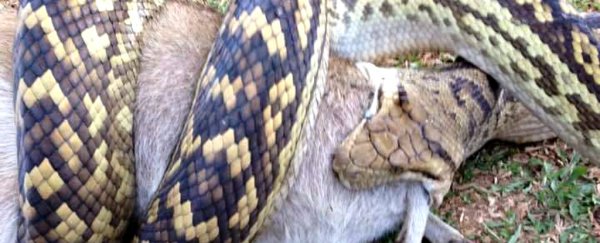Nature often surprises us with both its beauty and brutality. But we still weren't prepared for photos released this week of a python in Australia swallowing an entire wallaby and its joey. Because, how??
The images were captured by north Queensland resident Bernie Worsfold, who stumbled upon the scene mid-meal, and tried unsuccessfully to rescue the joey from its mum's pouch.
Despite barely being able to wrap its head around the wallaby, the python somehow managed to devour the entire marsupial whole, and the incredible images below have been shared more than 27,000 times. Even that poor horse looks confused about what the eff is going on.
If you need a close-up of the snake's head, here you go:
Worsfold also captured some NSFW footage of the event:

So what's going on here? Henry Kacprzyk, curator of reptiles at the Pittsburgh Zoo told ScienceAlert that the images show a scrub python (Morelia amethistina), which is one of the six largest snakes in the world.
Worsfold estimated that this specimen was around 4 metres long, but there are reports of them growing up to an impressive 6 to 7 metres (20 to 23 feet).
Their usual diet is made up of birds, rats, possums, and other small mammals - and it's not unheard of for them to prey on wallabies. In fact, another python was spotted doing the same thing on a golf course a few weeks ago.
But usually they choose wallabies that are juveniles or small individuals - this wallaby and her joey were a particularly large meal.
"I got fascinated by it because I've seen bigger snakes, but this one, his head was the size of your hand. And when he opens up, his mouth, his jaw was the size of the wallaby," Worsfold told The Brisbane Times.
"It was most fascinating thing to see the muscle in his body suck the wallaby in, as the other part of his body was squeezing the meal."
According to Worsfold, the entire meal took several hours to swallow, before the snake slinked off into the bush. So how is that possible?
Contrary to popular belief, the reptiles don't actually dislocate their jaws, instead, they're attached with very elastic ligaments.
"One of the enduring myths about snake feeding mechanisms is the idea that the jaws detach," biology professor Patrick T. Gregory from the University of Victoria in Canada told Live Science back in 2012.
"In fact, they stay connected all the time. The two mandibles are not joined at the front by a rigid symphysis, as ours are, but by an elastic ligament that allows them to spread apart."
So after first suffocating its prey, a python is able to stretch its mouth around it, and then gradually 'shuffle' its way forward until it engulfs the entire thing.
Once the meal is in a python's stomach, the digestive system goes into overdrive.
This system shuts down between meals, but after prey has been swallowed, the snake's metabolism goes crazy and organs enlarge to three or four times their normal size as they release enzymes to break down food.
That means that over the next few days and weeks, while this python digests its dinner, it'll puff up even larger in size before the wallaby is finally digested. During this time, the snake will be pretty much immobilised, so will stay out of sight from potential predators.
Sadly, the wallaby was carrying a joey, which Worsfold tried to save but arrived a few seconds too late.
Like we said, nature is brutal. Especially in Australia.
